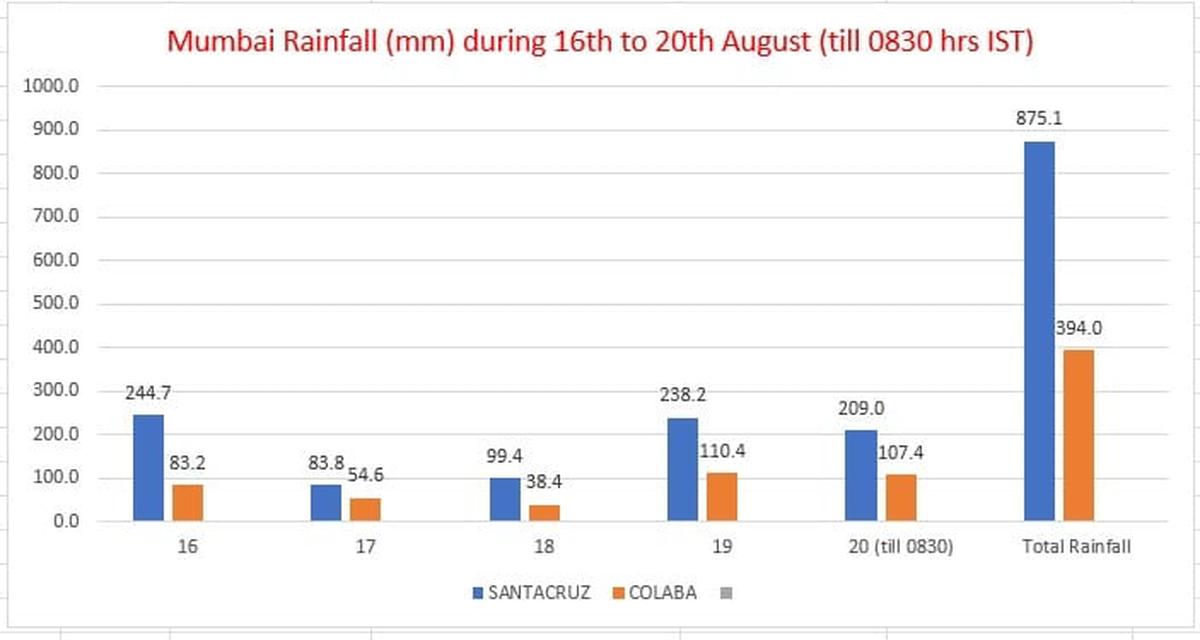Our Terms & Conditions | Our Privacy Policy
Mumbai rains: Extreme rainfall intensified by climate change and multiple weather systems, warn scientists, climate experts
Incessant rains have battered Mumbai and its suburbs for four consecutive days, disrupting normal life across the city. Experts have warned that climate change is intensifying extreme rainfall events and stressed the urgent need for early warning systems and adaptation strategies.
Mumbai rains LIVE: IMD issues orange alert; airlines announce travel advisory
The India Meteorology Department (IMD) has predicted that heavy rains will continue for the next 24 hours, after which the intensity is expected to decline, though moderate showers will persist.
Rainfall crosses monthly average
After a dry July, extremely heavy rains returned to Mumbai around August 16. By the afternoon of August 19, the city had recorded more than 800 mm of rainfall, surpassing its monthly average of 560.8 mm.
Multiple weather systems behind torrential rains
Meteorologists have attributed the intense downpour to the alignment of multiple weather systems.
“A low-pressure area over Vidarbha, a cyclonic circulation over the Northeast Arabian Sea, a depression over the Bay of Bengal, and an active offshore Monsoon trough have resulted in vigorous Monsoon conditions over coastal Maharashtra, particularly Mumbai,” said Mahesh Palawat, vice-president of Meteorology and Climate Change at Skymet Weather.
He added that when such systems align simultaneously, they “tend to complement each other, intensifying weather activity.”
Mumbai rainfall from August 16 to 20, 2025.
| Photo Credit:
Photo credit: IMD
Climate change amplifying rainfall patterns
Climate Scientist Dr. Raghu Murtugudde, Emeritus Professor at the University of Maryland and retired IIT Bombay professor, explained that while heavy three-digit rainfall is not new to Mumbai, climate change is acting like a “steroid.”
“The northward swing of monsoon winds is pulling massive moisture from the warm Arabian Sea into the northern Western Ghats,” he said. “This shift is influenced by global warming, especially warming over the Middle East, combined with natural variability in monsoon winds.”
A recent study, Middle East Warming in Spring Enhances Summer Rainfall Over Pakistan, shows that the Middle East is warming nearly twice as fast as other inhabited regions, increasing atmospheric instability and intensifying rainfall across northwest India and Pakistan. The study attributes 46% of the increased rainfall in the region between 1979 and 2022 to this rapid warming.
Mumbai’s wettest August in years
Dr. Akshay Deoras, Research Scientist at the National Centre for Atmospheric Science, University of Reading, the U.K., said Mumbai’s current downpour follows “the city’s driest July since 2015.”
“This torrential rain is caused by strong monsoon winds, intensified by two low-pressure systems — one over east India and another over the Gulf of Khambat,” he said. “While the precise role of climate change in this event needs further study, shorter, more intense rainfall matches what we expect in a warming world.”
Rain wreaks havoc in Maharashtra, brings Mumbai to a standstill
Experts stress citizen-centric early warning systems
According to Dr. Subimal Ghosh, Institute Chair Professor at IIT Bombay, the only way forward is improving early warning systems.
“The exponential warming of the Arabian Sea has increased moisture influx along the West Coast,” he said. “We need a robust network of early warning and nowcast systems for urban flooding, and they must be citizen-centric so that people can make informed decisions.”
He highlighted IIT Bombay’s Mumbai Flood Monitoring System, which provides real-time data to stakeholders.
Need for better coordination and planning
K.G. Ramesh, former Director General of the IMD, stressed the need for better inter-agency coordination.
“Forecasting has improved, but timely dissemination is the key,” he said. “We must identify high-risk zones, prepare evacuation plans, and set up defined escape routes. With extreme weather becoming frequent, preparedness is critical.”
Dr. Vishwas Chitale, Fellow at the Council on Energy, Environment and Water (CEEW), emphasised mapping flood-prone areas and upgrading city infrastructure.
“Solutions must include better drainage, increased green cover, and an Intensity-Duration-Frequency (IDF) mechanism that predicts which parts of the city will get the heaviest rainfall,” he said. “This will help authorities plan water discharge and manage urban flooding.”
Planning for a resilient future
CEEW has already prepared a Thane City Action Plan for Flood Risk Management 2024, based on 52 years of rainfall data. The plan develops ward-wise urban flood risk indices, designs intensity-duration-frequency curves, and identifies vulnerable hotspots.
Abinash Mohanty, Global Sector Head for Climate Change and Sustainability at IPE Global, warned that India’s megacities are increasingly exposed to extreme rainfall.
“Floods rank highest among natural disasters in terms of losses,” he said. “Streets turning into rivulets and vehicles getting submerged have become routine for Mumbai’s 12 million residents.”
IPE Global, he added, is supporting the BMC in developing an AI-ML-powered Multi-Hazard Risk Atlas to climate-proof Mumbai’s infrastructure, livelihoods, and lives.
Experts said that in climate scenario, such events would become reoccurring and advance warning systems are the way, be it in Mumbai or in the Himalayas.
Published – August 20, 2025 12:11 pm IST
Images are for reference only.Images and contents gathered automatic from google or 3rd party sources.All rights on the images and contents are with their legal original owners.





Comments are closed.